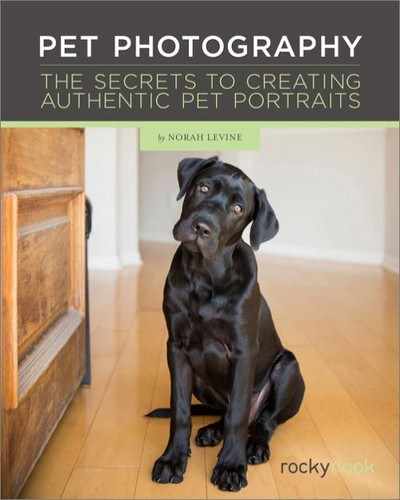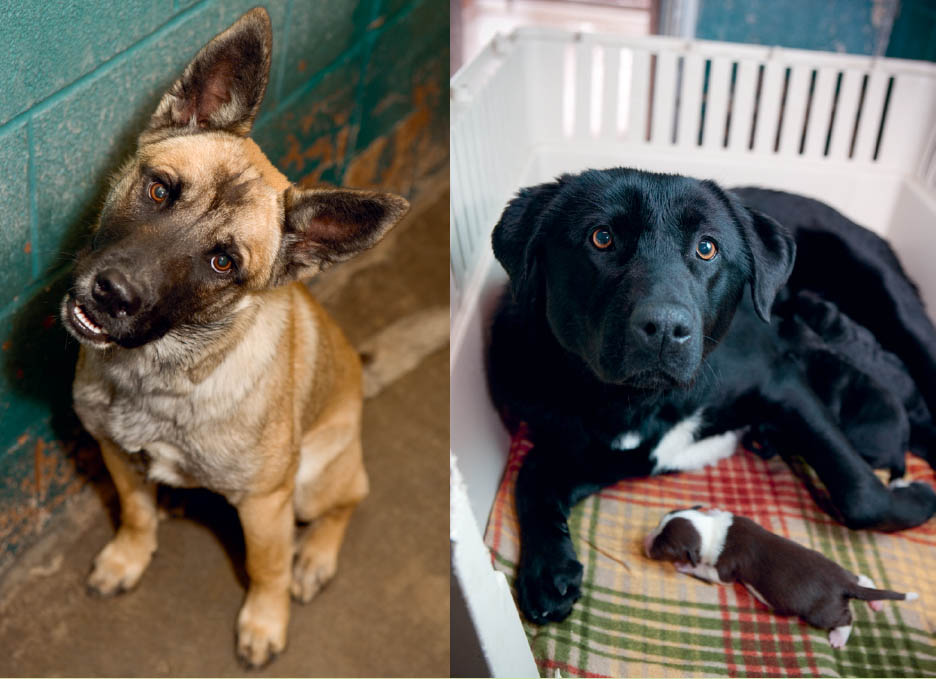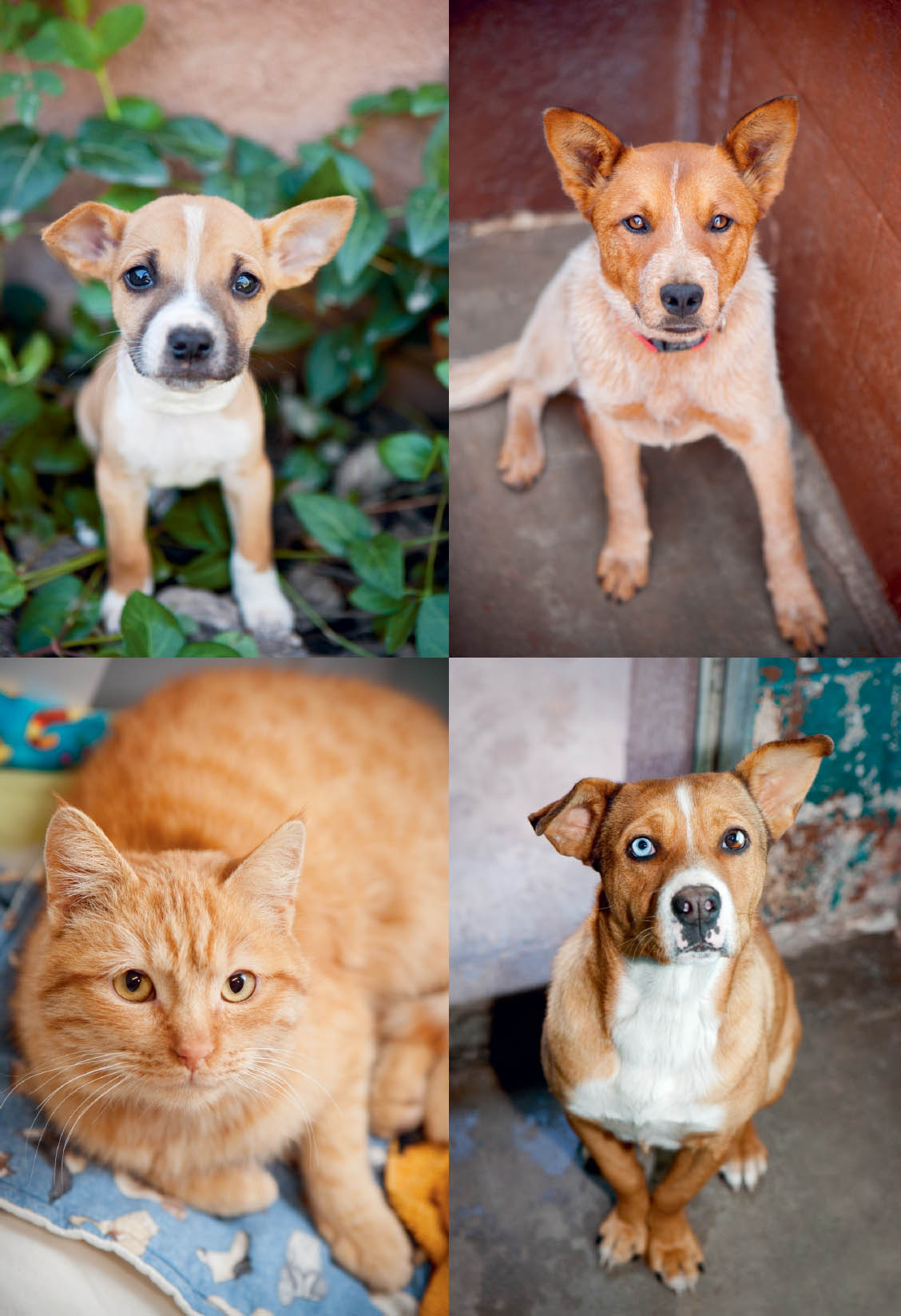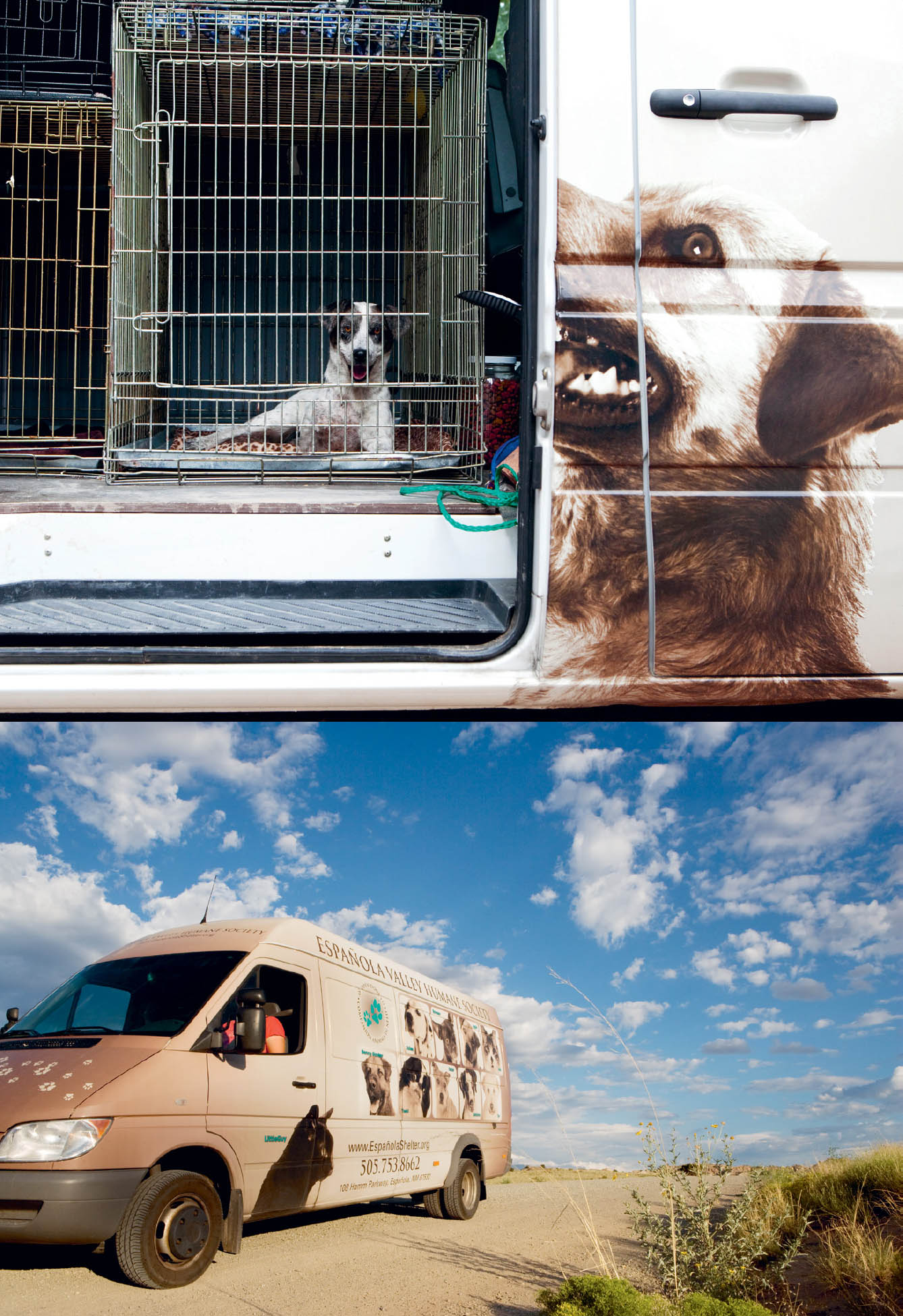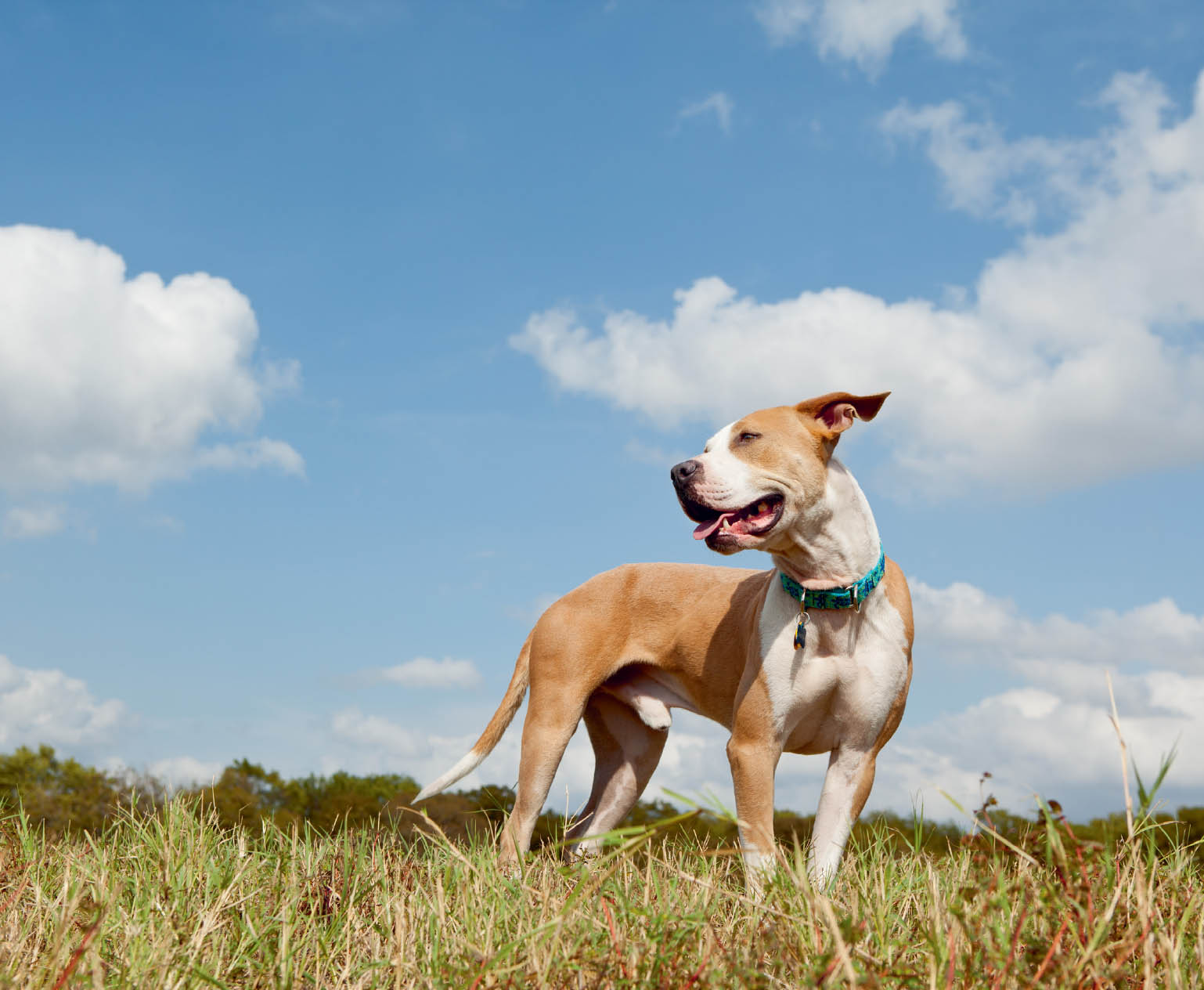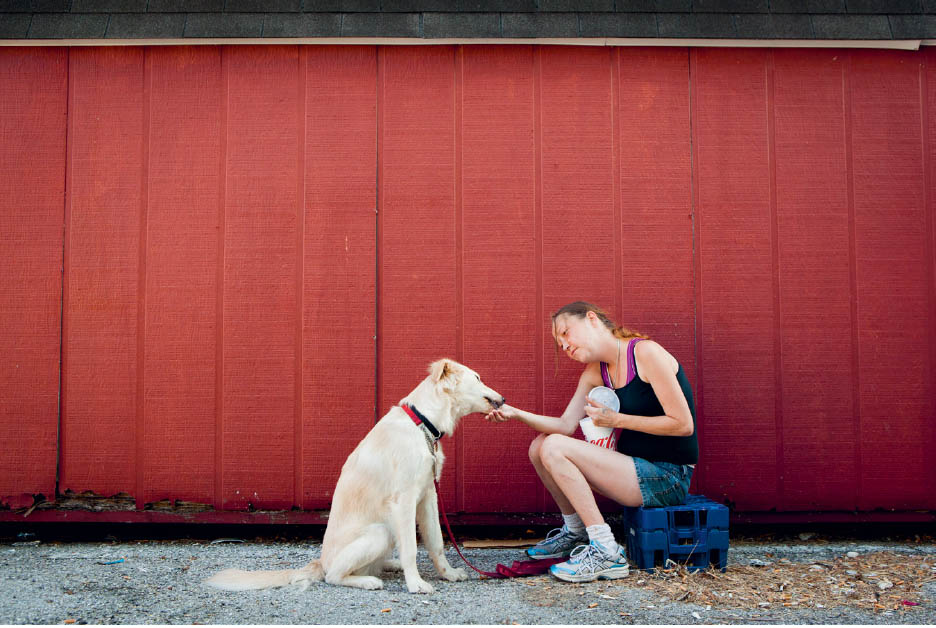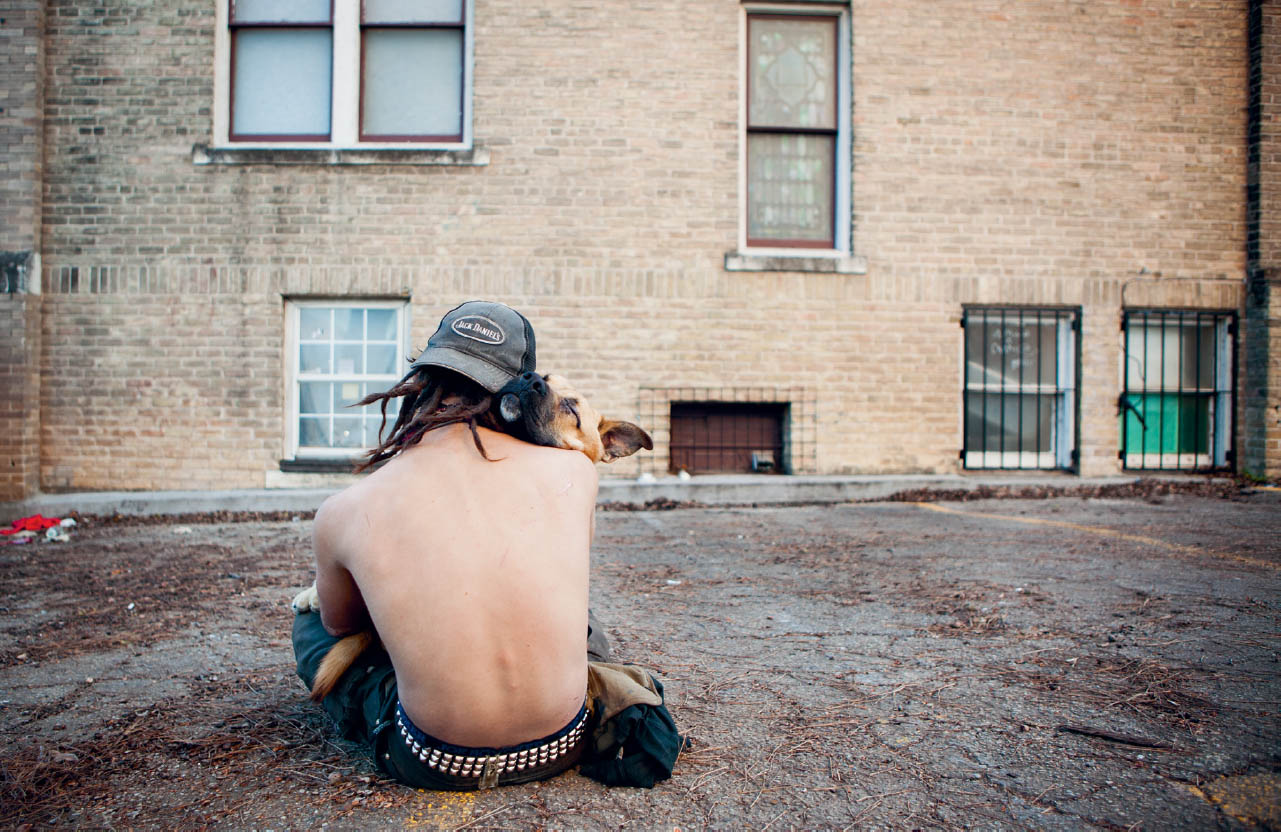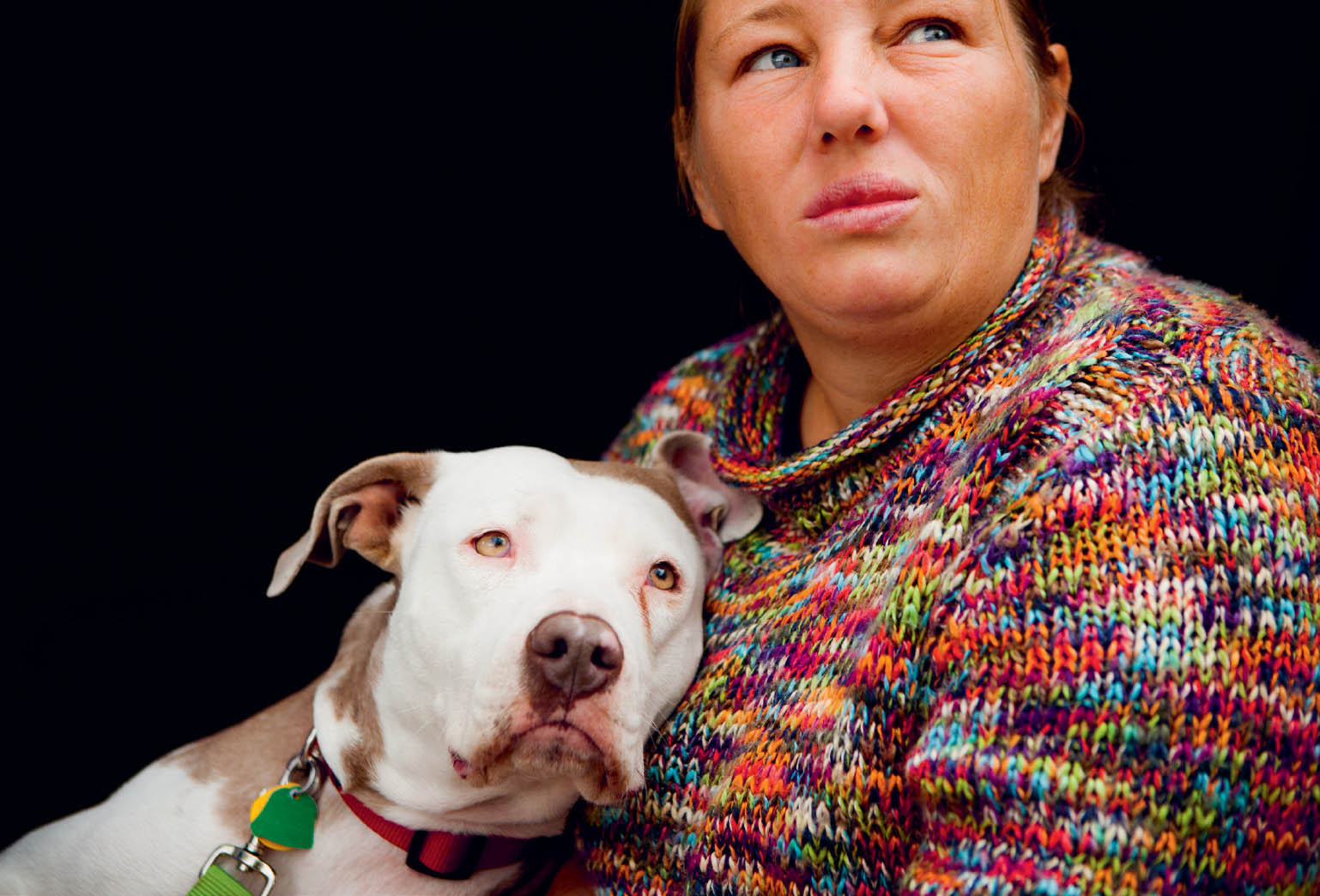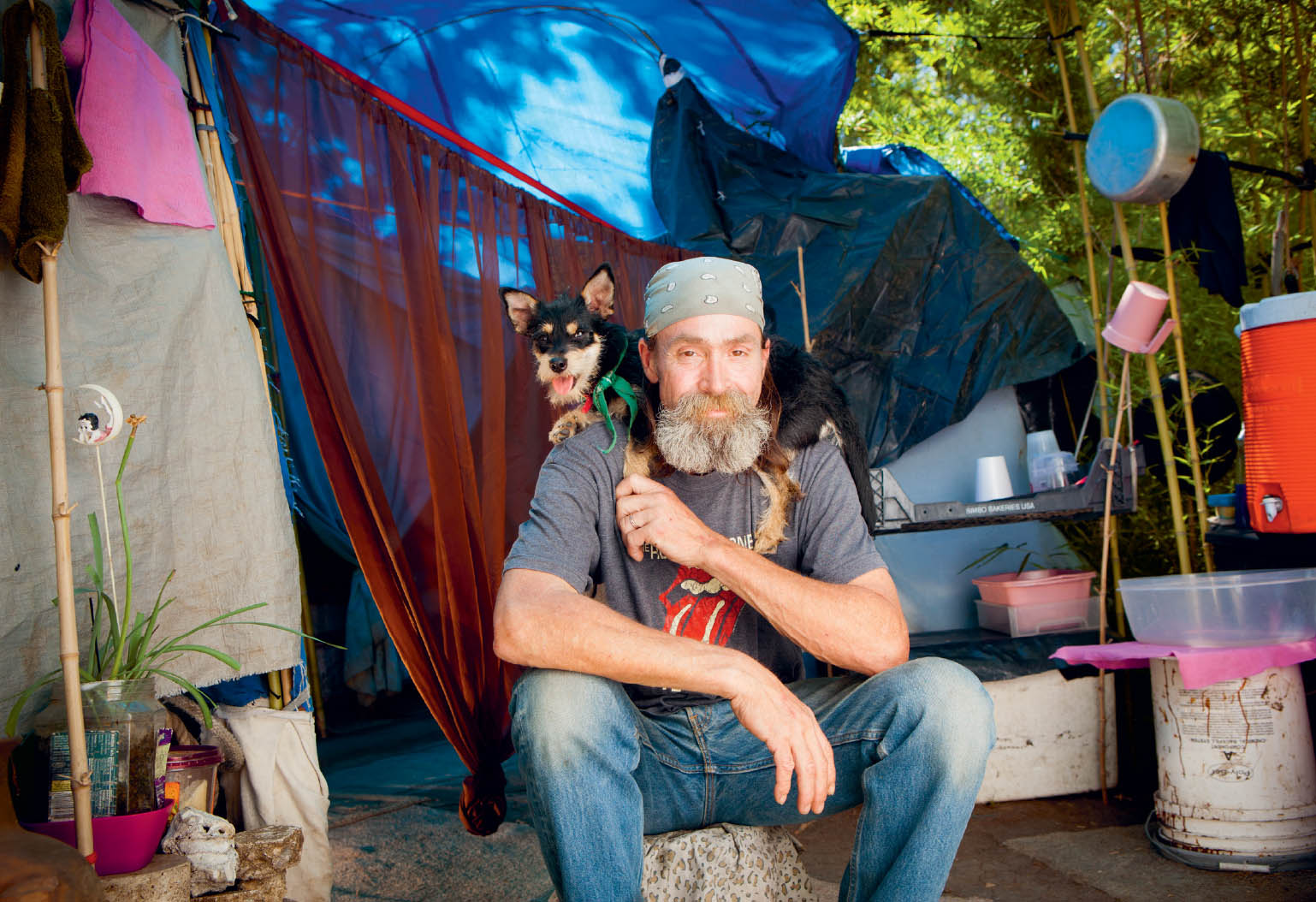CHAPTER 10: PHOTOGRAPHING FOR NONPROFITS: GIVING BACK AND COLLABORATING
Chances are that if you’re interested in pet photography, you have an affinity for animals. Regardless of whether you’re involved with pet photography as a business or hobby, I highly encourage you to get involved with animal organizations and start contributing with your camera. Collaborating with nonprofits has been one of the most rewarding elements of my career as a pet photographer.
Photographing for Adoption
As I mentioned earlier in this book, photographing for my local animal shelter helped me gain valuable experience in working with animals. Unfortunately, many animal shelters are full of animals, and as a result there is a tremendous need for strong imagery to help them find homes.
LEARNING OPPORTUNITIES
Getting started photographing animals in shelters was especially difficult for me, because I felt emotional about the animals and their situation. Knowing that I couldn’t adopt them all broke my heart—and I know this is a struggle for many photographers. In order to be able to continue contributing with my camera, I had to recognize the value in creating appealing imagery of these animals to highlight their beauty, to make finding a home more likely. Because many people search the Internet for adoptable pets, the photographs play a significant role in the animals’ adoption chances—which makes this work very rewarding.
Because there are so many animals with unique personalities in one place, animal shelters are great places to help AND learn as a pet photographer.
Photographing in animal shelters taught me so much about the communication signals of dogs and cats, and it helped me build my awareness of their behavior in general. While I had pets of my own, photographing in a shelter gave me the opportunity to interact with a variety of characters, whose personalities ranged from extremely shy to super energetic and intense. Learning to understand so many different temperaments required a lot of patience and helped me build self-awareness in terms of how I engaged with animals.
During some visits to the Española Valley Humane Society (just north of Santa Fe, New Mexico), I would photograph 20 dogs and 15 cats, each personality different from the next. Because each animal had a unique temperament, I had to use a variety of approaches to get their attention—which was really good training for me! With some I made loud, exciting noises with my mouth so that I could keep my hands free; whereas others required more subtlety, such as hanging out in their kennel for a bit or offering a treat. As I photographed each animal, I paid special attention to their body signals, looking for signs of stress. My goal was to engage with each one and show their best-possible character, in spite of the stress they may be experiencing in a shelter environment.
For some dogs and cats, being photographed wasn’t their favorite thing, but as long as I did my best to make them comfortable, I felt that a little bit of stress for the purpose of finding them a home was legitimate. Of course, in those types of situations, I didn’t go beyond what was necessary in terms of capturing images; I’d get what I needed and move on.
TECHNICAL AND LOGISTICAL ISSUES
When you photograph in a shelter, you need to think and respond fairly quickly and navigate some less-than-ideal lighting conditions. This is a great way to prepare for photographing in someone’s home, where the lighting conditions can be challenging. Most of the time I used a flash and practiced bouncing the flash and diffusing it so that it was soft and appealing. Where possible, I would photograph with ambient light.
When I photographed in shelters as a volunteer, I would sometimes have an assistant or helper, while other times I found it was easier to capture the images on my own, especially with cats. If you choose to volunteer for this purpose, the shelter you connect with may pair you up with another volunteer to streamline the process.
Because there are often quite a few animals that need photographs, spending a long period of time with each animal might not be feasible, especially if you have another volunteer with you. These situations are good practice in thinking and responding quickly.
Also it’s important to recognize that the shelter situation can be stressful for animals, so they may not be able to respond in the same way they would if they were in a comfortable home environment. Photographing shelter animals isn’t the easiest way to explore pet photography, but it certainly offers many benefits for both you and the animals.
AESTHETIC CONSIDERATIONS
While there are certainly exceptions and a lot of variation, animal shelters are not known for being aesthetically pleasing, and this often meant that I needed to figure out ways to simplify backgrounds and make sure that the animal was featured in the most flattering way possible. I often did this by using a shallow depth of field and tried to avoid photographing any fences or gates whenever possible. I loved using a colorful blanket (approved by the shelter for use) as an out-of-focus background to add some vitality and contrast to the images. Just a little splash of color can go a long way.
If you have the opportunity, try photographing the dog or cat away from the confined space of the shelter kennels and cages and in a “warmer” environment like a garden area, or in the case of cats, an interior or exterior play area. Shifting the environment helps the potential adopter envision that animal as part of their family and induces positive, rather than negative, emotions—which can be a challenge with images created in shelters. I have even seen some very sweet images that implement props or involve adoptable pets wearing necklaces or costumes. I love seeing the creative ways that photographers and volunteers help animals look their best and find homes.

I enjoyed the opportunity to photograph this little kitty in a home environment while she was in foster care.
FOSTER CARE
For a variety of reasons, shelters may not be able to take in some animals; for example, they may require special care before they can be around other animals. In these cases, foster care is required. Some organizations are actually structured entirely on a foster care system and do not have a physical location at all. Photographing animals in a foster care home can be a great chance to create beautiful portraits for their potential adopters. You may be able to get involved by contacting your local animal shelter to find out if they have a foster care program or do some online research about other established foster care programs near you.
HOW TO BEGIN VOLUNTEERING IN SHELTERS
The physical facility and operational procedures of animal shelters can vary dramatically from organization to organization. Some shelters have teams of volunteers and a waiting list to help, whereas others are thirsty for assistance. Because of the variety in these organizations, your experience aligning with an animal shelter or humane society will also differ from one to the next. If you find a group that feels like a good fit, I encourage you to share your photographic skills to help homeless animals and the organizations that support them.
Start by looking on the shelter or humane society’s website for listed volunteer opportunities and information. If this is not available, you may be able to find a phone number so you can call and ask about volunteering. Some humane societies even have volunteer coordinators, and if so, you can reach out to them.
Once you establish a connection, you will need to adhere to that specific shelter’s volunteer training, if any, to be able to interact with the animals safely and according to the shelter’s guidelines. Make sure that you are clear on which animals you are allowed to interact with (or not), based on health or behavior issues. No matter what, you want to make sure that you feel comfortable with the animals you’re photographing.
As you begin to volunteer your time, my hope is that you start to develop a solid relationship with the organization, hone your photographic and awareness skills around all kinds of temperaments, and help some amazing animals find homes.
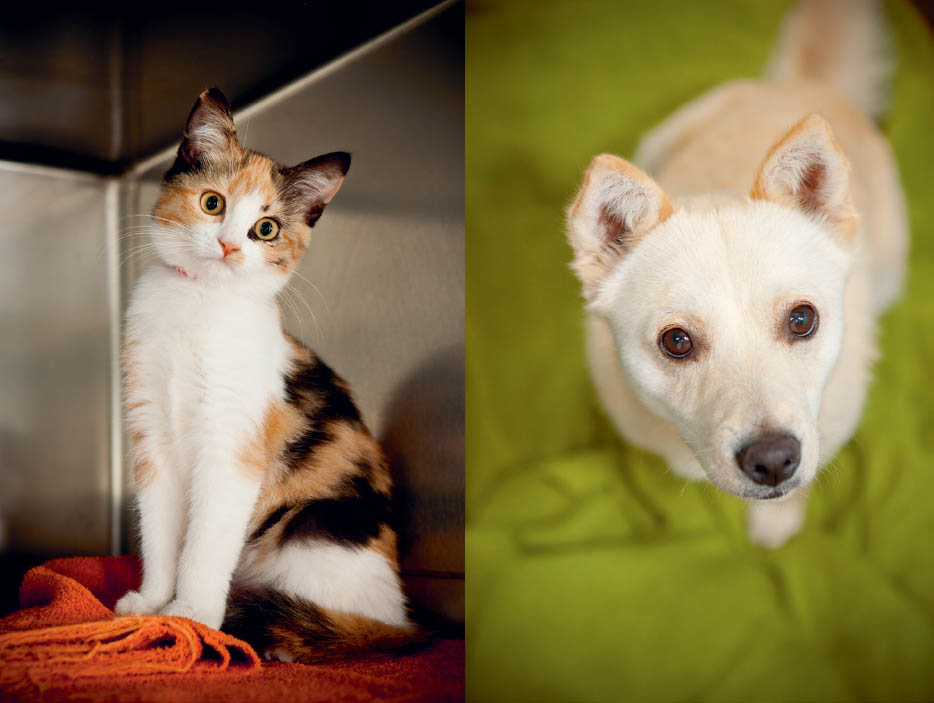
In addition to photographing animals in need of adoption, there are lots of creative ways to collaborate on marketing efforts and special projects for nonprofits. In addition to promotional imagery, special projects and fundraisers are also great ways to get involved and connect with your favorite animal welfare group.
MARKETING AND FUNDRAISING CAMPAIGNS
It’s no secret that impactful images help sell products and convey messages to consumers. Even though animal welfare organizations are very different from a brand of jeans or sports drink, for example, imagery used for nonprofit animal welfare organizations is effective in very similar ways. Photography helps animal welfare groups keep the community and their donor base in tune with their message and presence. Compelling images seen on websites and social media, in print, and in e-newsletters have the potential to catch a viewer’s eye and perhaps lead them to pause for a moment and consider donating, adopting, or getting involved in the organization in some other way.
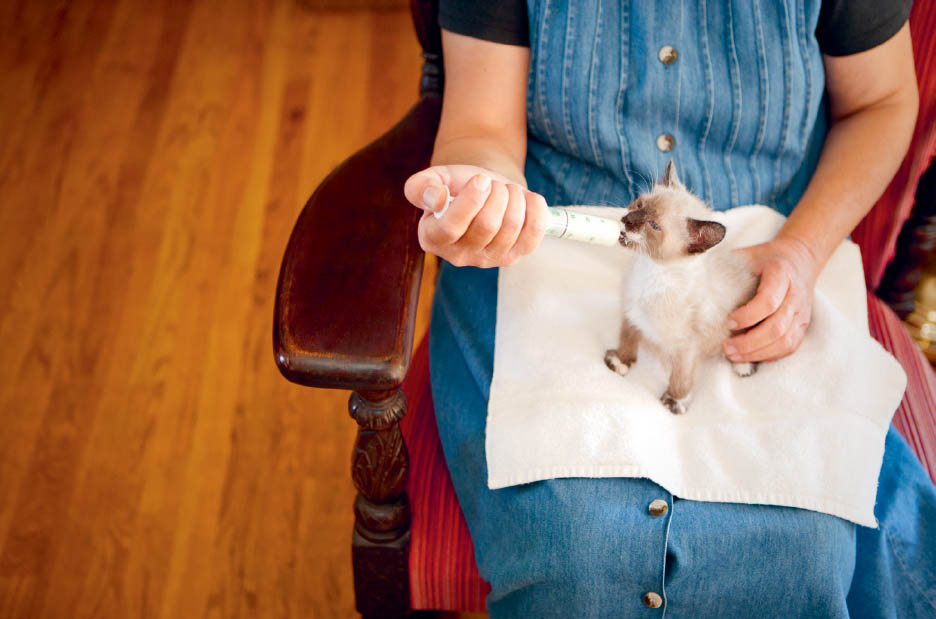
This image was part of a small marketing book of images intended to illustrate the many positive aspects of the Española Valley Humane Society in northern New Mexico. This particular image was representative of their foster care volunteers.
I photographed Lill as part of the marketing project for Española Valley Humane Society. She beautifully represented the shelter and all the possibilities that come from adopting a dog and perked up quite nicely after hearing the crinkle of a potato chip bag. Lill was adopted from the shelter in 2008. She went on to become a registered therapy dog with Pet Partners and primarily visited schools and worked with children, but in later years visited hospice patients as well.
I am very inspired by the possibility of supporting a meaningful cause by generating imagery that has the potential to reach a wider audience. I have really enjoyed working on animal welfare marketing campaigns and appreciate participating on longer-term projects that contain a succinct body of work.
If you are interested in these kinds of opportunities, you may want to start building a relationship with an organization you care about and sharing your ideas, as well as listening to theirs. Keep in mind that it may take some time to cultivate these relationships.
SPECIAL EVENTS AND PROJECTS
Animal welfare groups often host creative events to help their cause, and photography can certainly play a valuable role in these kinds of activities. You may even come up with your own ideas and pitch them for consideration. Mobile adoption events, calendars, photo booths, auctions, fashion shows, dog walks and races, and fundraising galas are just some of the activities that call for a photographer. As a new pet photographer, especially, this can be a great way to meet new people and get involved in the animal welfare community. Donating a pet photography session can help you meet new clients and also generate needed funds for the group.
While in New Mexico, I created a group of dog and cat portraits that were later printed and wrapped on the organization’s mobile adoption van. This was a really fun project that helped raise money for the shelter and gave the donors an opportunity to have their pet featured on the outside of the van. These kinds of special projects are great ways to get involved as a photographer and animal lover.
This van wrapped in pet portraits transported puppies from New Mexico to Colorado for adoption.
GIVING BACK . . . SUSTAINABLY
Should you donate all of your time and skills? When should you or can you get compensated for your time, talent, and images? What’s the right thing to do? These are important questions to consider when it comes to collaborating and doing work for animal-related nonprofits. Unfortunately, there is not one “right” answer to these questions. My hope is that I can guide you in the process so that you can determine what’s best and possible for you. Keep in mind that what is right for you may not be right for someone else, is based on many factors, and can change dramatically depending on these factors. Where you are in your career, your creative goals, your financial situation, and your other commitments can all impact your decisions.
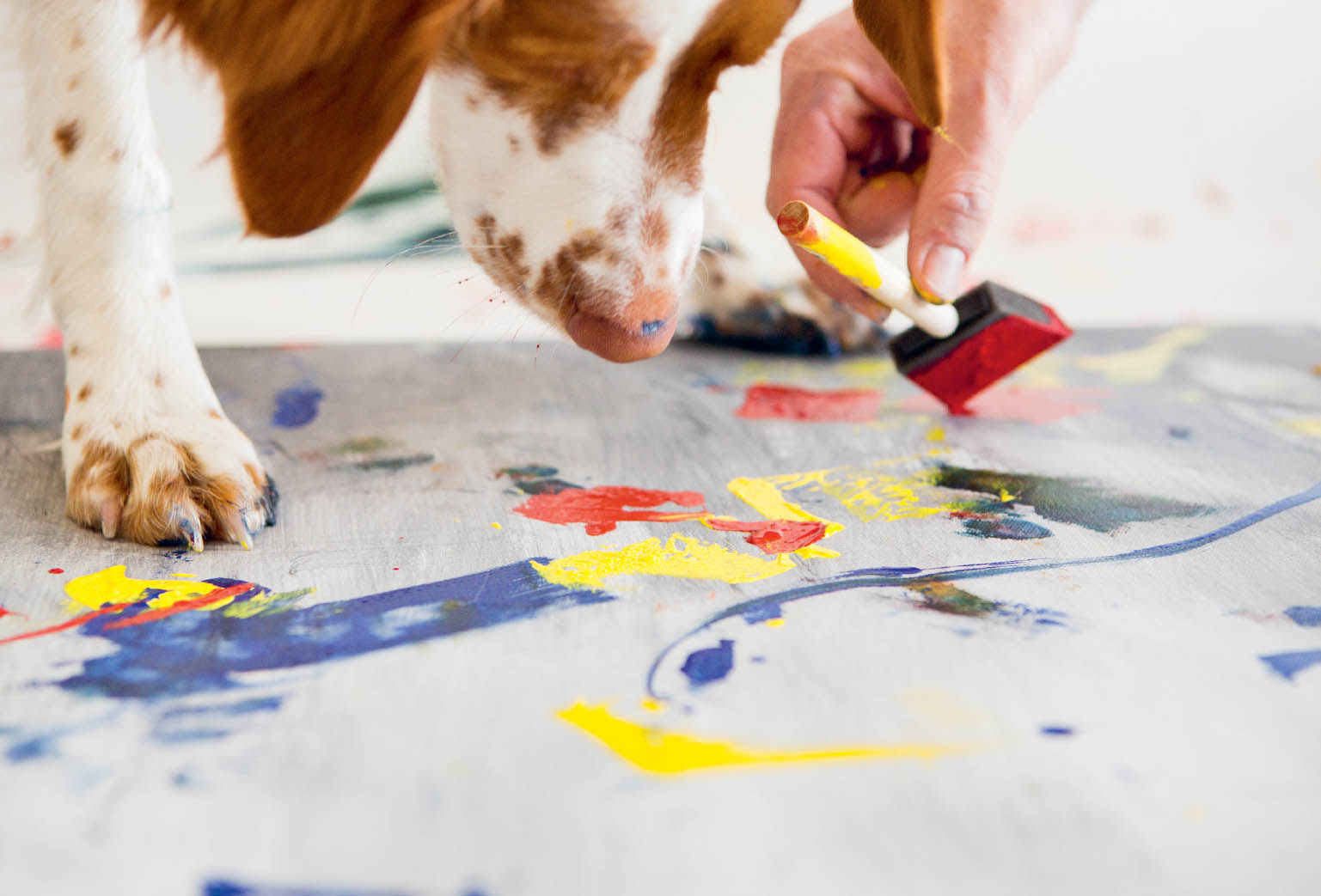
For a few years in a row, I was able to donate my services and images for a unique fundraising project in which paintings were created by dogs in collaboration with local artists, helping to raise money for a local animal welfare group. This was a once-a-year project that felt sustainable for me.
If you’re like me, money can be a difficult topic to address, and talking about it with nonprofit organizations can be especially uncomfortable. They are, after all, nonprofits and often have limited access to funds. In addition, if you get paid for your services on any level, you may have the concern that you’re taking away from the animals. These are valid considerations but aren’t necessarily the case.
Whether pet photography is a hobby or your profession, it is an honor to help animals and organizations we believe in, and I 100-percent support donating some of your time and talent for these purposes. I’ve addressed some of the ways you can contribute by creating portraits of adoptable animals, photographing a fundraising event, or donating to an auction. But keep in mind that just because you enjoy taking photographs and love animals, you are not required to give beyond what you feel is right for you.
If you are a professional photographer, you will likely want to consider what is sustainable for your business and for you as an image-maker. Projects can range from a one-day event to longer-term commitments. There is a seemingly endless need for high-quality photography in the nonprofit world, and you are ultimately responsible for navigating how and if you contribute. If you choose to donate, I encourage you to do so with clarity and to feel really good about it.
Although photography has certainly become more accessible thanks to digital technology, being involved with photography doesn’t come without financial investment, as you likely already know. Photography on a professional level involves expensive camera and lighting equipment that constantly requires upgrading, a computer and software, insurance, marketing costs, and so on. Consider that when you are donating your time, you are not making money with your other photography projects or spending time getting clients, so I encourage you to find situations that not only feed you creatively but also feel sustainable for your business in general.
This image was created for the Austin Humane Society’s annual calendar fundraiser, a volunteer-based project that involved many photographers’ contributions.
To help me make decisions about whether I can or should pursue new projects, I’ve started to practice asking myself some questions: Is the subject matter within the scope of my interests?
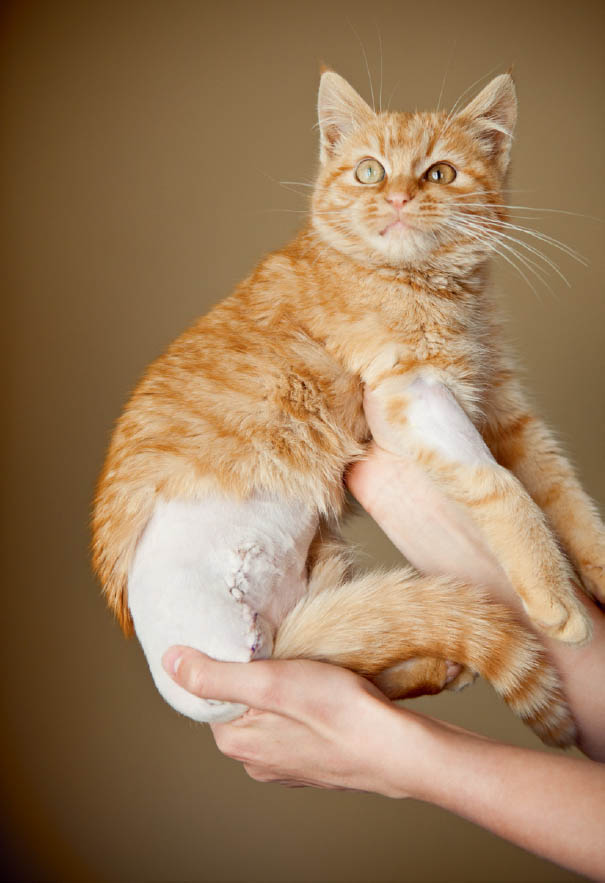
I created this image as part of a special project for the Española Valley Humane Society, to help raise funding for special medical cases. These stories touched my heart, and I was glad to be able to donate my services for the cause. I appreciated the challenge of creating beautiful photographs of emotionally painful situations.
- Will it challenge or fulfill me creatively?
- Would this offer me helpful experience that I could take with me to develop another project?
- Does the time commitment feel possible given my other projects and life priorities?
- Do I feel inspired to make a difference with the project or activity?
- Is this project financially sustainable given its parameters? Is it donation-only or is there an opportunity to receive financial support?
- Will it bring me joy?
Spending a little time answering these questions can help generate some clarity around nonprofit projects that may come up. Some of these questions might seem “selfish,” but in the interest of sustaining my business, I often need to protect and nurture it. I love helping animals and people, and at the same time, I need to honor what feels right for me and continue to be able to do this work for many years.
Photographing animals available for adoption is most likely going to be voluntary work, and unless the shelter has a full-time photographer, I really think this activity should be volunteer-based. However, larger projects, marketing campaigns, and other events may be funded.
If you’re interested in a project and determine that you would require some funding to make it sustainable, take the time to discuss possibilities with the organization. Ask if they have a budget for a project or if there is a possibility to obtain a grant to cover your costs or compensate you as photographer.
Because I have been clear about what is sustainable for me and my business, I have been involved in some projects for animal welfare groups that were funded. Although my fees were significantly lower than they would have been for a for-profit business, being compensated on some level made working on the project doable. In these circumstances, the organizations I dealt with were happy to make an investment, because they valued how the imagery could help their organization spread a message to their donor base and clientele.
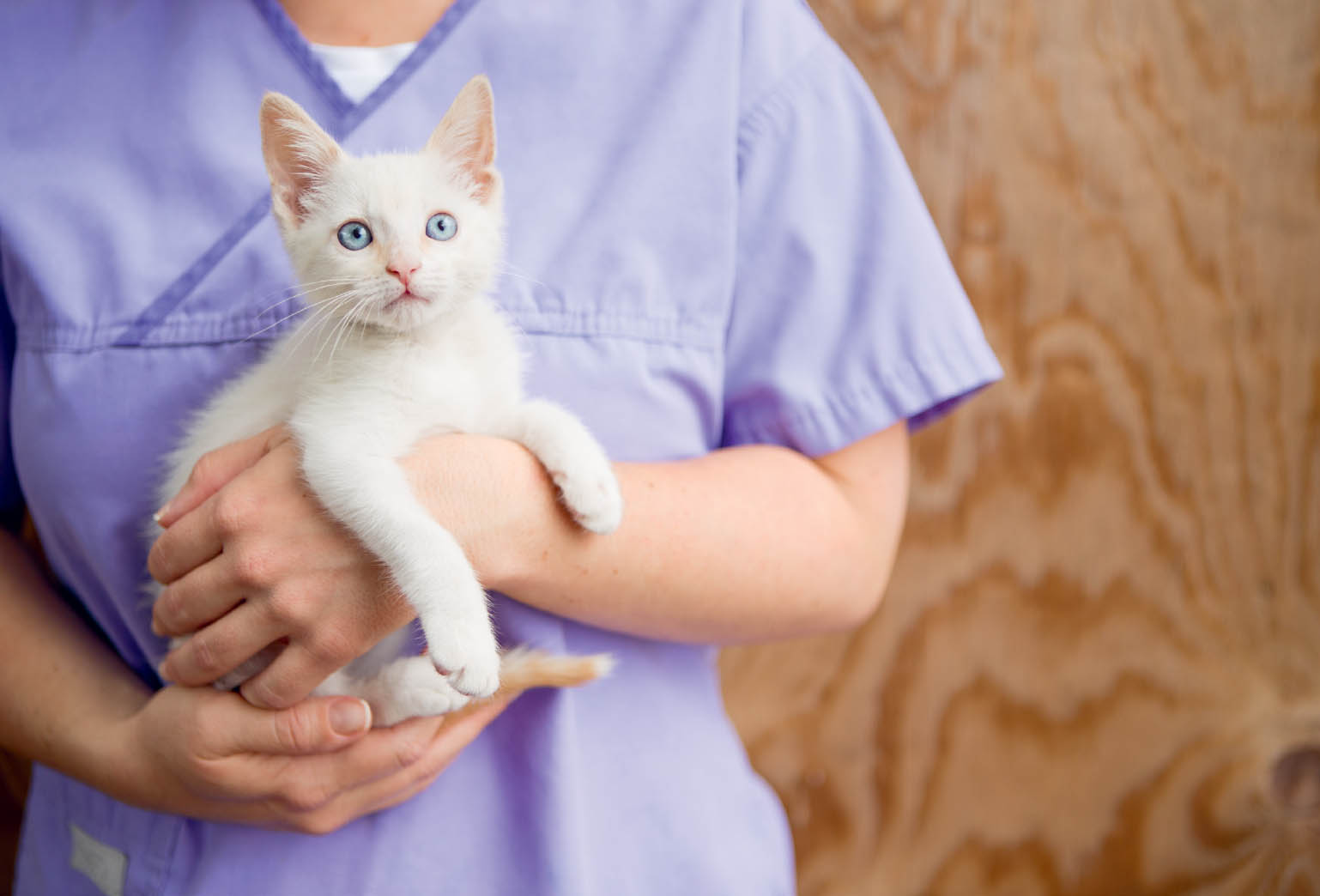
This image was created as part of a marketing campaign for Animal Trustees of Austin (now Emancipet). Text and graphics were later placed over the image to promote their services for the community. In order to make this project sustainable for me, I collaborated with the organization at a discounted rate.
Sometimes you may really want to get involved in a project because it just feels like something you can stand behind, and it will bring you joy and creative fulfillment.
Personal projects are long- or short-term visual explorations that can be adopted purely as a creative outlet, a new challenge, a way to get outside your “norm” or comfort zone, or a way to produce social change or awareness. These projects can be large or small in scale, simple or complex, serious or fun, shared with no one or many. If you’re finding yourself in a creative funk, personal projects can be a great way to refresh yourself and expose yourself to something different.
My experience with a personal project taught me a great deal about myself as a photographer and person and was one of the most rewarding endeavors I’ve ever undertaken. In sharing my experience and process of pursuing this project, I hope to inspire you to pursue any curiosity you may have for a personal project.
THE LIFELINES PROJECT
The Lifelines project is a personal project involving environmental portraits of homeless people and their pets and is dedicated to honoring their incredible bond. Rather than focus on the inherent sadness of homelessness, the idea was to create authentically joyful images in a similar manner to how I would approach photographing for my clients living in homes.
Not only did the process of creating the images change my perspective, but it also showed me the value of committing to a long-term endeavor for which I had curiosity. Much to my surprise, the project transformed into something much bigger than myself.
THE BEGINNINGS
When I moved to Austin, Texas, from Santa Fe, New Mexico, I was eager to build community and get involved with the animal welfare world, as it was such an important part of my life in New Mexico. I connected with Animal Trustees of Austin (now merged into an incredible organization called Emancipet [www.emancipet.org]) to learn about their programs in the hopes of being able to contribute with my photography.
“Rose with Junior” from the Lifelines project.
When I learned about one of their programs, which provided free services to the pets of the homeless, I was immediately inspired to start a personal project. With the organization’s blessing and the valuable help of one of their employees at the time, Gabrielle Amster (co-creator of the Lifelines project), I was eager to begin. I would have a head start in finding subjects by connecting with clients who had used the organization’s services and who might be willing to participate in the project. My hope was to create portraits and capture short audio pieces that would help build awareness around the need for providing veterinary services to the pets of the homeless. I called it the Lifelines project, because I felt it perfectly referenced the close relationship between people and their pets. I wasn’t initially clear what would happen with the images and audio after they were created, but I anticipated sharing them with the public somehow—perhaps in an exhibit.
Over the course of the photo shoots, we shared information about the Animal Trustees of Austin programs and brought some supplies for the animals, and Gabrielle even coordinated appointments for some of the participants.
THE INTENTION
I wanted to create images and capture audio that focused on the relationship between homeless people and their pets in a way that was beautiful and sincere and that allowed the viewer/listener to shift possible judgments about who “should” and “shouldn’t” own a pet. I wanted the love conveyed in the images and audio to invite a sense of empathy into the narrative. We may not think we have anything in common with a homeless person, but so many of us can identify with how it feels to love a pet. I wanted this commonality to open people’s minds and, ultimately, help the pets of the homeless get the care and support they needed to stay together and stay healthy.
When I initially envisioned the project, I hoped that the pets were being treated with love and that I would be able to create authentic portraits of beneficial, loving partnerships. I promised myself that if in the process I did not find this to be the case, I would stop. While I can only speak from my experiences, I was grateful to find the majority of the relationships to be mutually beneficial and positive.
I wanted the audio pieces to allow the listener to further understand the value of the relationship between each person and their pet, specifically, as people living on the streets. Gabrielle did an incredible job producing the audio pieces for the project, and I really think these pieces added tremendous value to the project.

“Maggie and Eric with Dixie and Reptar” from the Lifelines project.
“Connor with Super Max” from the Lifelines project.
Part of what helps me capture authentic moments between people and animals is spending time interacting and engaging. For the Lifelines project, I wasn’t interested in grabbing snapshots of people and pets as I walked by in the streets. It was a priority for me to take a little time to allow them to be comfortable in front of the camera and focus on their relationship with their pet.
THE PROCESS
Throughout the course of a year, we photographed and interviewed about 20 people-and-pet combinations. Most of the photo shoots were scheduled (surprisingly, this worked out about 85 percent of the time) and were created in places where the subjects spent time. Some of the people we met while spending time on the streets, and those photo shoots happened on the spot.
The locations for the photo shoots were chosen based solely on where the person I was photographing spent time in some way; I didn’t scout or choose the general locations. The backgrounds varied and included camps in the woods, bridges, street sidewalks, parking lots, and even a culvert. Just as I would with my portrait clients, I made intentional aesthetic choices within the given location to highlight the subjects’ connection. I didn’t bring outfits for the dogs or people, nor did I style the locations.
Some of the people I photographed had been homeless for years, whereas others were new to the streets. Some were young travelers, only staying in the city for a short period of time before moving on to another location, and others were more settled. While I was certainly interested in each person’s life story, my focus remained on their bond with their pet.
I wanted to keep my equipment and presence pretty low-key so as not to make the people and animals I photographed feel insecure about the added attention a lot of equipment can attract (and it would have been difficult to bring a lot of gear to some of the locations). I always brought my camera, a small flash unit with a softbox on a pole, a reflector, and a diffuser. Most of the images were shot with ambient light, but I did use the flash on occasion.
The photo shoots and interview process lasted about an hour, sometimes less, and the overall experience seemed fun for those we connected with. Just like you and I, the subjects had a great deal of pride in their pets and their relationship with them. When they talked about their pet, there was a sparkle in their eye and a smile on their face. Their animals were their family.
THE CHALLENGES
Logistically, finding and coordinating with subjects would sometimes prove to be a challenge, as they would move around the city a lot, and getting in touch with people was a little difficult. Many homeless people have pay-as-you-go cell phones, which would often run out of minutes. Locations weren’t always easy in terms of lighting or were physically challenging to navigate, but we always figured out something that worked in the end. Capturing the audio was also challenging, as there was usually a lot of ambient sound.
Emotionally, being involved in this project required significant investment. Homelessness is not a beautiful or simple thing. I felt sympathetic to the difficult lifestyle of being homeless and the many complicated issues surrounding it. Sometimes I felt guilty that I wasn’t doing enough. However, in order to complete the project and be able to share the beauty I witnessed in the relationships, I needed to stay focused on the positive aspects of what I was encountering. I knew that I couldn’t solve the issue of homelessness, but what I could do was continue creating portraits in the hopes of making a difference with my images.
WHAT I DISCOVERED
In the years following this project, I’ve given a lot of thought to what I learned in the process. Homelessness can be heartbreaking, stressful, and dangerous—and, I am quite sure, feel very lonely to those who face it. It is a complicated issue, and by no means does this project intend to ignore its nuances or make it seem dreamy, nor am I an expert on homelessness after spending a year on a project. But I do feel that the relationships I witnessed between these people and their pets are positive ones and that they need to be supported by our community. Of course, like with people who have homes and shouldn’t care for a pet, there are exceptions; but in general, I believe that these animals truly are lifelines to these people, just as they are to those of us fortunate enough to have a roof over our heads. These animals deserve to be cared for, and just because their owner might not be able to pay for their care doesn’t mean that relationship shouldn’t exist. These pets get to spend all day and night with their pet owners, an opportunity that my pets—and most people’s pets—do not have.

“Lynn with Charlie” from the Lifelines project.
There are so many benefits of having a pet, including how they can affect our mental and physical health. Imagine how much more impactful that relationship might be if you were living on the streets?
I am so grateful that my love of photography and animals gave me such a meaningful experience.
EXHIBITING AND SHARING THE WORK
I printed and delivered the portraits to as many of the subjects I photographed as I could reach. I am truly grateful for their participation in the project and for their willingness to share their relationship with others.
My immediate goal for sharing the images was to generate funds to print them on aluminum and have them exhibited locally in Austin. This vision came into reality and then some. After the money was raised through an online fundraising campaign (via Indiegogo), I had the images printed on large aluminum in vivid color. The images were exhibited in a gallery space and Austin City Hall and also in Los Angeles at The Animal Museum (formerly the National Museum of Animals & Society) and in their pop-up shows around the United States. The Lifelines prints are now part of the museum’s permanent collection (www.theanimalmuseum.com).
The Lifelines images have been shared online via The Huffington Post and Yahoo.com and throughout the world via online publications including MSN in Africa, Italy, Brazil, Malaysia, Ireland, Japan, and elsewhere. The images have been shared on many blogs and websites, and they have been used in educational materials to support bringing social change and laws into effect.
I received many heartfelt, positive emails from people around the world telling me that the images touched them and gave them a new perspective. In their own words, people expressed their love of their own pets and donated funds to the animal welfare program that inspired the project. I have had the honor to speak about this project and have been truly amazed to have received such a tremendous response. The images and project have become much larger than myself—and that is truly powerful.
I share the reach of this project not to toot my own horn, but rather, hopefully to inspire you to take action to pursue your own curiosities—to see where your vision might take you. Your projects don’t need to be shared around the world to be rewarding or impactful, but exploring your creative interests can be such a powerful experience. I had no idea I would have the opportunity to share my images to the extent that I have, but I learned that having the curiosity and commitment to pursue the creation of the images was the only way I could start to open up the possibilities. I feel grateful that so many people were able to see the work and that the images and voices made some impact that I may not even be aware of.
WHAT YOU CAN DO
I want to encourage you to keep your eyes and ears open for ideas that pique your curiosity. Not all of your projects need to be socially impactful or serious or involve an animal welfare organization. You can create projects purely for fun and aesthetic exploration—and that’s great, too.
You may have lots of ideas but still don’t know how to find subjects and get started. I suggest generating a list of people and businesses that have the greatest reach to the people and animals you’d like to connect with. For example, if you have an idea for photographing spotted dogs, you might want to connect with a doggy daycare, dog trainer, or groomer so that you can connect with potential subjects. Do what you can to extend your reach as far as possible with the least movement so that you can spend more time and energy on the photographic aspect of the process.
You may feel a pull to explore a project that involves an animal welfare or rescue group, and if so, I encourage you to take some steps toward that goal.
If you don’t have a specific idea in mind, you can start with a sense of inquiry. Connect with an animal welfare group in your area, and try to find out about programs and initiatives they’re currently involved in and projects they have in the works. It may help to build a relationship with the group first, but it’s not always necessary. You may be able to connect with a volunteer coordinator, a marketing specialist, or anyone in the organization who can speak with you and brainstorm ideas. Ask questions that will help you learn about possible ways you might get involved. Find out where there are gaps in the story that the organization is trying to tell.
If an idea surfaces for you and aligns with the organization, you can choose to take it on as a personal project or see if there is any budget to make it sustainable. You will also want to have the organization’s blessing. You may find that you will be required to take a lot of initiative and left to do your own thing, or they may choose to get very involved. Try to find an arrangement that feels right for you and the organization.
“Sandra with Harley” from the Lifelines project.
You don’t have to know exactly where your project is going to go from the beginning, and it can be helpful to recognize that the trajectory may very well change. You may discover that you don’t love the project as much as you thought you would, and it may generate an idea for an entirely new direction.
If you do choose to create a project, I’d love to hear about it. Getting involved with causes I believe in has been one of the most rewarding aspects of being a pet photographer. My hope is that I can encourage you to take a step toward something you are curious about and see where it takes you.
The camera is a powerful tool, and it’s pretty incredible that we have the ability to participate in something we enjoy, cultivate our own creativity, practice our skills with people and animals, generate awareness for a cause, help animals find homes, creatively preserve memories between loved ones, and spread joy with our imagery.
I hope this book has been valuable for you. Maybe it has encouraged you to pursue your interests in pet photography or given you the information and motivation to take your work to the next level, or the extra bit of confidence you need to dabble with pet photography on the weekends. Whatever your next steps are . . . enjoy!
It’s been my honor to share my experiences and observations with you, and I invite you to stay connected with me. I’d absolutely love to see what you’re up to and continue the journey together.
You’ve got this!
VISIT NORAH’S WEBSITE OR CONNECT WITH HER ON SOCIAL MEDIA:
“Jedd with Alice” from the Lifelines project.
